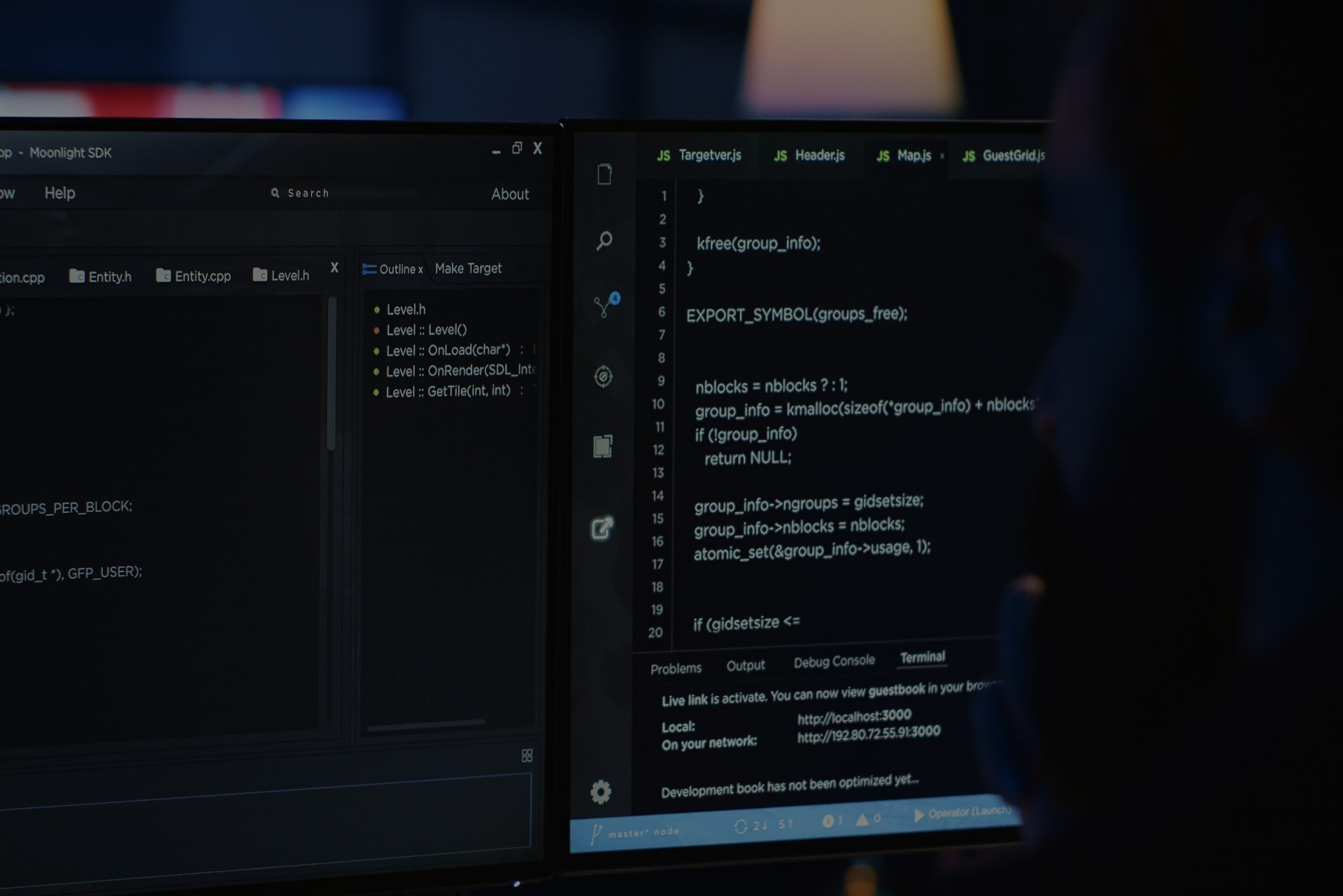
March 7, 2025
Outsourcing Transformed: How AI is Redefining the Landscape of Software Engineering
Our latest article highlights five major ways AI is transforming software development, making it faster and more precise. These AI tools boost productivity by guiding developers and predicting their next steps. Let’s connect if you’d like personalized advice on applying these tools to your own projects. |
Reading time: 15 min.
The Intersection of AI and Software Development
AI, once a distant ambition, is now embedded in the core of software engineering—a force redefining how code is written, tested, and deployed.
This technology has moved from simple task automation to nuanced, predictive tools that analyze, adapt, and optimize at speeds previously unimaginable. And it’s no longer just about efficiency. AI is shaping development with intelligence that complements human creativity, guiding each line of code and anticipating the issues of tomorrow.
This shift isn’t happening in isolation. It’s fueling a boom in outsourcing as businesses look outward for the expertise needed to harness AI’s power. The IT outsourcing market is projected to hit $541.1 billion in 2024, with growth aimed at $812.7 billion by 2029. The United States will lead this charge, generating $197.3 billion in revenue, underscoring a growing reliance on AI-driven outsourcing.
For companies, AI outsourcing offers an unprecedented advantage—a way to unlock innovation, manage complexity, and stay agile without the steep cost of in-house development. This transforms software engineering, reshapes what’s possible, and defines the competitive edge for those willing to take the leap.
In our new article, we dig deep into the essentials, peeling back the layers of this game-changing approach.
Let’s dive in.
AI-Powered Tools Revolutionizing Software Development
In the world of software development, AI-powered tools are quietly, yet decisively, reshaping the very fabric of how code is written, optimized, and perfected. This is a structural shift, a recalibration of the developer’s role and the coding process itself. From generating code to predicting errors, these tools are altering the pace and precision of the work, much like a skilled pilot guided by the latest navigation technology while remaining firmly in control.
Now, let’s explore the 5 AI-powered tools that can revolutionize software development:

This image shows 5 AI-powered tools businesses can leverage.
1. Intelligent code generation and completion
Take intelligent code generation and completion, for instance.
Tools like OpenAI's Codex, GitHub Copilot, and Tabnine are not merely supportive; they’re predictive. They analyze vast libraries of code, detect patterns, and, like a seasoned co-author, anticipate the developer’s next move. Imagine a junior developer, tasked with building a customer data form, receiving precise code suggestions that handle input validation in seconds, as if a seasoned engineer were whispering in their ear. These tools reduce the laborious, time-consuming work, allowing developers to focus on strategy rather than syntax.
2. Automated code optimization and refactoring
But AI’s reach extends beyond code generation.
Automated code optimization and refactoring platforms such as Sourcery and Resharper go a step further by fine-tuning existing code to enhance its efficiency and maintainability. That's what these tools do, ensuring every line is as concise and practical as it can be, ultimately creating code that's both elegant and resilient.
3. Natural language processing for programming
Natural language processing (NLP) for programming marks a significant leap, bridging the gap between human thought and machine language.
NLP-based tools translate plain language into structured code, making programming accessible to those outside the technical sphere. It’s as if a foreign language interpreter suddenly stepped in, breaking down barriers and making complex syntax understandable and executable for non-developers. Now, a product manager can provide specifications in natural language, and the system itself translates them into workable code, accelerating development and collaboration.
4. AI-assisted debugging and error prediction
Meanwhile, AI-assisted debugging and error prediction act as a developer’s second set of eyes, spotting potential issues before they even surface.
Platforms using predictive algorithms and machine learning can identify problematic code sections, allowing developers to course-correct early. No more combing through code for hours—AI flags bugs on the spot, speeding up the development process and sidestepping potential costly errors.
5. Machine learning in testing and quality assurance
Finally, machine learning in testing and quality assurance is reimagining the testing phase altogether.
These tools can predict test scenarios, create test cases, and even assess the quality of the code. Testing and quality assurance become more than just a series of steps. They become a dynamic and absolutely adaptive process, driven by data and refined with each iteration.
Advantages of using AI for Software Development Outsourcing

This image illustrates fields of AI use in software development.
By improving both speed and precision, AI is making waves in software development outsourcing. Below, we explore the top advantages of integrating AI into your development process:
AI-Powered Development: Benefits for Speed, Quality, and Security
| Advantage | Description |
| Increased Speed of Software Development | AI tools shave down the time to deliver, accelerating code generation and refining workflows. Projects are completed faster, putting companies ahead of the competition. |
| Enhancing Decision-Making Processes | Development teams gain insights they could only dream of before. Real-time analytics and predictive models offer a roadmap for more precise, informed decisions—decisions made not on guesswork but on data. |
| Automation of Repetitive Tasks | AI is changing the rules of the game for developers, taking care of routine work like formatting and documentation. Now, they’re free to focus where it matters most—on tackling the tough challenges and driving truly valuable innovation. |
| Elevating Code Standards to Keep Technical Debt in Check | AI takes on the role of a metіculous editor in software development, catching mistakes as they happen, making real-time іmprovements, and curbing technical debt that could bog down future projects. It’s a built-in safeguard for cleaner, stronger code. |
| Enhanced Testing and QA | Bugs—those silent threats to software reliability—are caught by AI-driven testing tools running countless test scenarios, adjusting to code changes, and delivering rigorous quality control that human hands alone can’t achieve. |
| Improved Software Security | AI’s watchful eye identifies vulnerabilities and unusual activity, providing the first line of defense. |
| Personalized Developer Experience | AI crafts a tailored experience, suggesting code based on individual habits and needs. It’s personalization at its best, making developers feel supported, understood, and ultimately, more productive. |
How AI is Reshaping Outsourcing Software Development
Shifting skill requirements for outsourced teams
A decade ago, outsourcing meant securing affordable coding skills for basic development tasks. Today, that equation has changed, and the skills required have transformed.
Take the case of a financial services company looking to deploy AI-driven chatbots to enhance customer support. This isn’t just about creating another chatbot. The outsourced team isn’t just coding replies to FAQs. They’re now expected to understand the nuances of natural language processing, design machine learning algorithms that can anticipate customer needs, and embed these insights into an adaptive, intuitive system. It’s about bringing the right kind of intelligence to bear on a thorny problem.
With Artificial Intelligence in software development taking over much of the repetitive work, firms are focusing their search on a talent pool that’s fluent in data analysis and familiar with automation tools.
And as always, there’s that unspoken requirement—the ability to communicate. It’s no longer enough to simply code in isolation; outsourced teams now have to explain AI models, present findings, and navigate project demands with clarity. The very structure of outsourcing is being reshaped, inch by inch, as companies seek specialized teams who can navigate a system that is, in many ways, as complex as the human brain itself.
AI-enabled project management and collaboration
AI driven software development offers something new: real-time insight, the kind that doesn't just watch the work but anticipates its obstacles, guiding teams toward smoother outcomes. For managers and developers, it’s a shift that moves past traditional reporting cycles into a realm where problems are flagged, analyzed, and acted upon before they reach a critical stage.
Imagine a global development team working across three continents on a high-stakes platform overhaul. Their AI-driven project management software, fueled by real-time data and sophisticated algorithms, keeps track of every task, flagging any signs of delay and pinpointing exactly where resources are needed most.
AI-enabled collaboration tools are removing the obstacles that once seemed unavoidable in outsourced settings: time zones, language barriers, and the inevitable friction of coordination. Natural language processing (NLP) tools are translating and summarizing messages on the fly, while AI-powered scheduling assistants find meeting slots across multiple time zones, optimizing schedules without the usual back-and-forth. What’s remarkable here is the way AI learns from each project, subtly refining workflows and identifying practices that drive efficiency, quietly reshaping the rhythm of collaboration.
Redefining pricing models and value propositions
For years, outsourcing revolved around the premise of offloading tasks at lower costs. But with AI in the picture, traditional cost structures are looking increasingly obsolete. Automated code generation, error prediction, and QA testing mean routine work that once took hours—or even days—can be completed in a fraction of that time. And this creates an opening for a different kind of pricing, one based not on the minutes clocked, but on the outcomes achieved.
Take a hypothetical example: a client engages an AI-enabled outsourcing firm to accelerate a software rollout. Rather than setting a fixed budget for projected hours, the contract might now hinge on metrics like project speed, code quality, or feature reliability. A faster time to market, higher software performance, fewer bugs—these are the deliverables AI in software development makes possible, and they’re what clients are increasingly willing to pay for.
This shift benefits both sides. The outsourcing firms, now incentivized to boost performance through AI, are reimagining the value they bring. Many are moving toward modular service offerings—predictive maintenance, continuous integration—that can be tailored to a client’s specific needs.
Geographical implications: Bridging skill gaps across regions
In the reshaped landscape of software outsourcing, AI is steadily eroding the traditional boundaries that once defined regional capabilities. This isn’t just about talent shortages anymore—it’s about a new, globalized skill set where the best minds come together, regardless of geography.
Now, American companies can tap into a top-tier team in, for example, Eastern Europe, using AI-powered project management and collaboration tools that bring precision to the coordination. The tools bridge these gaps, seamlessly translating code documentation, aligning syntax preferences, and, in real time, syncing developers across continents.
AI enables a kind of relay, a 24-hour cycle where development never stops. Engineers in one time zone hand off tasks at day’s end, leaving an organized, AI-curated roadmap for the next team just waking up across the globe. And, while these teams may have once struggled with communication and cohesion, today’s AI tools smooth the rough edges.
What we’re witnessing is AI’s relentless dismantling of traditional labor divisions, shifting from "outsourcing for affordability" to "outsourcing for access."
Final Words on Artificial Intelligence and Software Engineering
The future of software engineering with AI is about potential.
AI can revolutionize how your company operates and serves its customers—but finding the right in-house talent is tough with demand surging. The good news? AI outsourcing is a smart alternative. It’s practical, scalable, and it’s what forward-looking companies are already doing.
At Factor Dedicated Teams, we connect you with a deep pool of tech talent and experts equipped to help you integrate AI into your business strategy. Contact us, and we’ll walk you through the landscape with clarity. From answering questions to providing free consultation, we’ll help you see exactly how AI can transform your business in specific and actionable ways.
Don’t miss our updates





